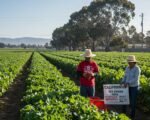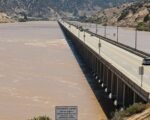California’s Stone Fruit Future Wilts Under Deepening Drought
California’s vital agricultural sector is facing a significant challenge as severe drought conditions persist across the state, casting a long shadow over the projected yield for the 2025 stone fruit harvest. Growers, particularly in the heart of the state’s agricultural engine, the San Joaquin Valley region, are bracing for substantial losses in key crops, including peaches, plums, and nectarines.
The prolonged lack of precipitation and resulting water cutbacks are taking a heavy toll on fruit trees. Agricultural experts and initial assessments from the field paint a grim picture, estimating that losses could reach a staggering 30-50% in some of the most heavily impacted counties, such as Fresno and Tulare. These counties are major producers of California’s stone fruit, supplying markets across the nation and internationally.
The Stark Reality for Growers
The impact on stone fruit trees stems directly from reduced water availability. With significantly less water allocated from state and federal projects, and depleted groundwater reserves, growers are forced to make difficult decisions. Insufficient irrigation leads to immense tree stress, reducing fruit size and quality, impacting overall yield, and in severe cases, causing tree mortality. Experts highlight that young trees are particularly vulnerable, and damage sustained during a severe drought can affect productivity for years to come.
The San Joaquin Valley region is the epicenter of this crisis for the stone fruit industry. Its fertile soil and warm climate are ideal for growing peaches, plums, and nectarines, making it a cornerstone of California’s agricultural output and a significant contributor to the local and state economy. The potential for a 30-50% reduction in yield in key counties like Fresno and Tulare represents not just lost revenue for individual farmers but a ripple effect throughout the entire agricultural supply chain, from harvesters and packers to distributors and local businesses that support farm operations.
Growers are reporting unprecedented water restrictions, forcing many to prioritize which trees or blocks receive limited water resources, potentially leading to abandonment of less productive areas. The water cutbacks and tree stress create a cascading problem – smaller fruit size reduces market value, while reduced quantity means less product to sell, severely impacting profitability and sustainability for farming operations.
Assessing the Damage and Economic Impact
Recognizing the severity of the situation, the California Department of Food and Agriculture (CDFA) is actively engaged in understanding the full scope of the crisis. The department is holding urgent consultations with growers and irrigation districts across the impacted regions. The primary objective of these discussions is to assess the full economic impact of the drought on the 2025 harvest and the broader agricultural community.
This assessment goes beyond just the value of the lost fruit. It includes evaluating the impact on agricultural employment, particularly seasonal harvest labor, which is crucial during the summer months. It also considers the financial strain on packing houses, transportation logistics, equipment suppliers, and other support industries that rely heavily on a successful harvest. The CDFA’s consultations aim to gather comprehensive data to inform potential state responses.
Political Response and Potential Aid
The growing concern over the potential economic fallout has prompted action at the state level. State legislators are reportedly fast-tracking discussions on a potential emergency aid package aimed at providing relief and support to the struggling stone fruit industry and other drought-affected agricultural sectors. The urgency stems from the need to provide support before the full impact of the reduced harvest is felt and to help growers mitigate further losses.
Details of the proposed aid package are still being finalized, but initial reports suggest it could include measures such as low-interest loans to help farmers cover operational costs, manage debt, and invest in water-saving technologies. Additionally, the package is expected to propose water conservation incentives to encourage the adoption of more efficient irrigation methods and practices that can help the industry adapt to the reality of scarcer water resources in the future.
These legislative discussions are moving swiftly, reflecting the gravity of the situation. The proposed emergency aid package is expected to be debated in early February 2025, a critical timeline for growers who need to make decisions about their orchards well in advance of the growing season.
Broader Implications and Outlook
The plight of the stone fruit industry in the San Joaquin Valley serves as a stark reminder of California’s persistent water challenges. While the state has experienced periods of relief, the long-term trend of drought and climate variability continues to pose an existential threat to water-intensive agriculture. The 2025 stone fruit harvest is just one indicator of this larger vulnerability.
Should the estimated losses of 30-50% materialize in key production areas like Fresno and Tulare, consumers could potentially see impacts in terms of availability and pricing of peaches, plums, and nectarines next year. For the agricultural communities themselves, the economic strain could be significant, affecting livelihoods and the vitality of rural economies dependent on farming.
The outcome of the legislative debate in early February 2025 will be closely watched by growers and the wider agricultural community. A robust and timely emergency aid package could provide a crucial lifeline, helping the industry navigate this severe drought and invest in a more water-resilient future. However, the fundamental challenge of water scarcity in California remains, requiring long-term strategies and investments beyond immediate drought relief.



















